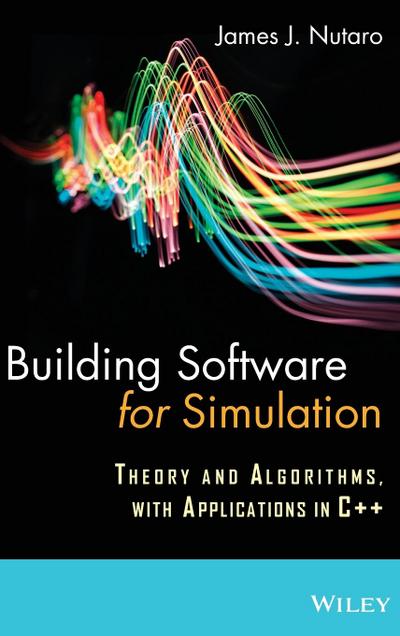
Building Software für Simulation: Theorie und Algorithmen, mit Anwendungen in - gebunden oder broschiert
ISBN: 9780470414699
Readers will explore the design of object-oriented simulation programs, simulation using multi-core processors, and the integration of simulators into larger software systems. The focus o… Mehr…
| ebay.de loveourprices2 97.8, Zahlungsarten: Paypal, APPLE_PAY, Google Pay, Visa, Mastercard, American Express. Versandkosten:Versand zum Fixpreis, [SHT: Expressversand], GL3 *** Gloucester, [TO: Großbritannien, Antigua und Barbuda, Österreich, Belgien, Bulgarien, Republik Kroatien, Zypern, Tschechische Republik, Dänemark, Estland, Finnland, Frankreich, Deutschland, Griechenland, Ungarn, Irland, Italien, Lettland, Litauen, Luxemburg, Malta, Niederlande, Polen, Portugal, Rumänien, Slowakei, Slowenien, Spanien, Schweden, Australien, USA, Bahrain, Kanada, Brasilien, Japan, Neuseeland, China, Israel, Hongkong, Norwegen, Indonesien, Malaysia, Mexiko, Singapur, Südkorea, Schweiz, Taiwan, Thailand, Bangladesch, Belize, Bermuda, Bolivien, Barbados, Brunei Darussalam, Kaiman-Inseln, Dominica, Ecuador, Ägypten, Guernsey, Gibraltar, Guadeloupe, Grenada, Französisch-Guayana, Island, Jersey, Jordanien, Kambodscha, St. Kitts und Nevis, St. Lucia, Liechtenstein, Sri Lanka, Macau, Monaco, Malediven, Montserrat, Martinique, Nicaragua, Oman, Pakistan, Peru, Paraguay, Réunion, Turks- und Caicosinseln, Aruba, Saudi-Arabi. (EUR 32.94) Details... |

2010, ISBN: 0470414693
[EAN: 9780470414699], Neubuch, [PU: Wiley], nach der Bestellung gedruckt Neuware - Printed after ordering - A unique guide to the design and implementation of simulation softwareThis book… Mehr…
| AbeBooks.de AHA-BUCH GmbH, Einbeck, Germany [51283250] [Rating: 5 (von 5)] NEW BOOK. Versandkosten:Versandkostenfrei. (EUR 0.00) Details... |

Building Software for Simulation : Theory and Algorithms, with Applications in C++ by James J. Nutaro - gebrauchtes Buch
ISBN: 9780470414699
A unique guide to the design and implementation of simulation software This book offers a concise introduction to the art of building simulation software, collecting the most important co… Mehr…
| BetterWorldBooks.com used in stock. Versandkosten:zzgl. Versandkosten. Details... |

ISBN: 9780470414699
1st Edition, by James J. Nutaro, PRINT ISBN: 9780470414699 E-TEXT ISBN: 9781119139935 Additional ISBNs: 1283025078, 1119139937, 9781283025072, 9781119139935 Wiley Global Research (STMS) e… Mehr…
| VitalSource.com new in stock United Kingdom. Versandkosten:plus shipping costs., zzgl. Versandkosten Details... |

Building Software for Simulation: Theory and Algorithms with Applications in C++ (eBook) - neues Buch
ISBN: 9780470414699
by James J. Nutaro, PRINT ISBN: 9780470414699 E-TEXT ISBN: 9781119095811 Additional ISBNs: 1283025078, 1119095816, 9781283025072, 9781119095811 Wiley Global Research (STMS) eBook Other pr… Mehr…
| VitalSource.com new in stock United Kingdom. Versandkosten:plus shipping costs., zzgl. Versandkosten Details... |


Building Software für Simulation: Theorie und Algorithmen, mit Anwendungen in - gebunden oder broschiert
ISBN: 9780470414699
Readers will explore the design of object-oriented simulation programs, simulation using multi-core processors, and the integration of simulators into larger software systems. The focus o… Mehr…

2010, ISBN: 0470414693
[EAN: 9780470414699], Neubuch, [PU: Wiley], nach der Bestellung gedruckt Neuware - Printed after ordering - A unique guide to the design and implementation of simulation softwareThis book… Mehr…

Building Software for Simulation : Theory and Algorithms, with Applications in C++ by James J. Nutaro - gebrauchtes Buch
ISBN: 9780470414699
A unique guide to the design and implementation of simulation software This book offers a concise introduction to the art of building simulation software, collecting the most important co… Mehr…
ISBN: 9780470414699
1st Edition, by James J. Nutaro, PRINT ISBN: 9780470414699 E-TEXT ISBN: 9781119139935 Additional ISBNs: 1283025078, 1119139937, 9781283025072, 9781119139935 Wiley Global Research (STMS) e… Mehr…
Building Software for Simulation: Theory and Algorithms with Applications in C++ (eBook) - neues Buch
ISBN: 9780470414699
by James J. Nutaro, PRINT ISBN: 9780470414699 E-TEXT ISBN: 9781119095811 Additional ISBNs: 1283025078, 1119095816, 9781283025072, 9781119095811 Wiley Global Research (STMS) eBook Other pr… Mehr…
Bibliographische Daten des bestpassenden Buches
| Autor: | |
| Titel: | |
| ISBN-Nummer: |
Detailangaben zum Buch - Building Software for Simulation: Theory and Algorithms, with Applications in C++
EAN (ISBN-13): 9780470414699
ISBN (ISBN-10): 0470414693
Gebundene Ausgabe
Erscheinungsjahr: 2010
Herausgeber: Wiley Core >2 >T
347 Seiten
Gewicht: 0,640 kg
Sprache: eng/Englisch
Buch in der Datenbank seit 2012-10-02T09:02:17+02:00 (Berlin)
Detailseite zuletzt geändert am 2023-05-31T13:36:26+02:00 (Berlin)
ISBN/EAN: 9780470414699
ISBN - alternative Schreibweisen:
0-470-41469-3, 978-0-470-41469-9
Alternative Schreibweisen und verwandte Suchbegriffe:
Titel des Buches: software, algorithms, simulation
Daten vom Verlag:
Autor/in: James J. Nutaro
Titel: Building Software for Simulation - Theory and Algorithms, with Applications in C++
Verlag: John Wiley & Sons
360 Seiten
Erscheinungsjahr: 2010-12-03
Gewicht: 0,686 kg
Sprache: Englisch
139,00 € (DE)
No longer receiving updates
167mm x 237mm x 25mm
BB; Hardcover, Softcover / Informatik, EDV/Informatik; Software Engineering; Computer Science; Informatik; Materials Science; Materialwissenschaften; Materialwissenschaften / Theorie, Modellierung u. Simulation; Programmierung u. Software-Entwicklung; Programming & Software Development; Simulation; Software Engineering; Software-Engineering; Softwareentwicklung; Theory, Modeling & Simulation; Programmierung u. Software-Entwicklung; Software-Engineering; Materialwissenschaften / Theorie, Modellierung u. Simulation
PREFACE. 1 INTRODUCTION. 1.1 Elements of a Software Architecture. 1.2 Systems Concepts as an Architectural Foundation. 1.3 Summary. 1.4 Organization of the Book. 2 FIRST EXAMPLE: SIMULATING A ROBOTIC TANK. 2.1 Functional Modeling. 2.2 A Robotic Tank. 2.2.1 Equations of Motion. 2.2.2 Motors, Gearbox, and Tracks. 2.2.3 Complete Model of the Tank's Continuous Dynamics. 2.2.4 The Computer. 2.2.5 Complete Model of the Tank. 2.3 Design of the Tank Simulator. 2.4 Experiments. 2.5 Summary. 3 DISCRETE-TIME SYSTEMS. 3.1 Atomic Models. 3.1.1 Trajectories. 3.1.2 The State Transition and Output Function. 3.1.3 Two Examples of Atomic, Discrete-Time Models. 3.1.4 Systems with Bags for Input and Output. 3.1.5 A Simulator for Atomic Models. 3.2 Network Models. 3.2.1 The Parts of a Network Model. 3.2.2 The Resultant of a Network Model. 3.2.3 An Example of a Network Model and Its Resultant. 3.2.4 Simulating the Resultant. 3.3 A Simulator for Discrete-Time Systems. 3.4 Mealy/Moore-Type Systems. 3.5 Cellular Automata. 3.6 Summary. 4 DISCRETE-EVENT SYSTEMS. 4.1 Atomic Models. 4.1.1 Time and Trajectories. 4.1.2 The State Transition Function. 4.1.3 The Output Function. 4.1.4 Legitimate Systems. 4.1.5 An Example of an Atomic Model. 4.1.6 The Interrupt Handler in the Robotic Tank. 4.1.7 Systems with Bags for Input and Output. 4.1.8 A Simulator for Atomic Models. 4.1.9 Simulating the Interrupt Handler. 4.2 Network Models. 4.2.1 The Parts of a Network Model. 4.2.2 The Resultant of a Network Model. 4.2.3 An Example of a Network Model and Its Resultant. 4.2.4 Simulating the Resultant. 4.3 A Simulator for Discrete-Event Systems. 4.3.1 The Event Schedule. 4.3.2 The Bag. 4.3.3 The Simulation Engine. 4.4 The Computer in the Tank. 4.5 Cellular Automata Revisited. 4.6 Summary. 5 HYBRID SYSTEMS. 5.1 An Elementary Hybrid System. 5.2 Networks of Continuous Systems. 5.3 Hybrid Models as Discrete-Event Systems. 5.4 Numerical Simulation of Hybrid Systems. 5.5 A Simulator for Hybrid Systems. 5.6 Interactive Simulation of the Robotic Tank. 5.6.1 Correcting the Dynamics of a Turn. 5.6.2 A Simplified Model of the Motor. 5.6.3 Updating the Display. 5.6.4 Implementing the Tank Physics. 5.7 Approximating Continuous Interaction Between Hybrid Models. 5.8 A Final Comment on Cellular Automata. 5.8.1 Differential Automata with Constant Derivatives. 5.8.2 Modeling Asynchronous Cellular Automata with Differential Automata. 5.8.3 A Homomorphism from Differential Automata to Asynchronous Cellular Automata. 5.9 Summary. 6 APPLICATIONS. 6.1 Control Through a Packet-Switched Network. 6.1.1 Model of the Pendulum and Its PID Controller. 6.1.2 Integration with an Ethernet Simulator. 6.1.3 Experiments. 6.2 Frequency Regulation in an Electrical Power System. 6.2.1 Generation. 6.2.2 Transmission Network and Electrical Loads. 6.2.3 Frequency Monitoring and Load Actuation. 6.2.4 Software Implementation. 6.2.5 Experiments. 6.3 Summary. 7 THE FUTURE. 7.1 Simulation Programming Languages. 7.2 Parallel Computing and Discrete-Event Simulation. 7.3 The Many Forms of Discrete Systems and Their Simulators. 7.4 Other Facets of Modeling and Simulation. APPENDIX A DESIGN AND TEST OF SIMULATIONS. A.1 Decomposing a Model. A.1.1 Bottom-Up Testing. A.1.2 Invariants and Assertions. A.2 Input and Output Objects. A.2.1 Simple Structures. A.2.2 Unions. A.2.3 Pointers and Hierarchies of Events. A.2.4 Mixing Strategies with Model Wrappers. A.3 Reducing Execution Time. APPENDIX B PARALLEL DISCRETE EVENT SIMULATION. B.1 A Conservative Algorithm. B.1.1 Lookahead. B.1.2 The Algorithm. B.2 Implementing the Algorithm with OpenMP. B.2.1 Pragmas, Volatiles, and Locks. B.2.2 Overview of the Simulator. B.2.3 The LogicalProcess. B.2.4 The MessageQ. B.2.5 The ParSimulator. B.3 Demonstration of Gustafson's and Amdahl's Laws. APPENDIX C MATHEMATICAL TOPICS. C.1 System Homomorphisms. C.2 Sinusoidal State-Steady Analysis. REFERENCES. INDEX.Weitere, andere Bücher, die diesem Buch sehr ähnlich sein könnten:
Neuestes ähnliches Buch:
9781119095811 Building Software for Simulation: Theory and Algorithms, with Applications in C++ (James J. Nutaro)
- 9781119095811 Building Software for Simulation: Theory and Algorithms, with Applications in C++ (James J. Nutaro)
- 9781119139935 Building Software for Simulation: Theory and Algorithms, with Applications in C++ (James J. Nutaro)
- 9780470877982 Building Software for Simulation (Andrew Coles)
- 9781118099452 Building Software for Simulation: Theory and Algorithms, with Applications in C++ James J. Nutaro Author (James J. Nutaro)
< zum Archiv...



